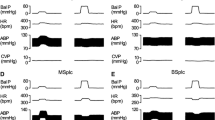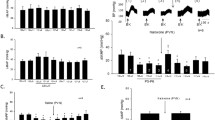Summary
Both visceral and somatic nociceptive stimuli elicit reflex changes in blood pressure and gastric motor activity, but the exact type of response varies with the type of nociceptive stimulus and its site of application. Therefore, the present study compared the effects of visceral (i. p. or i. a.) and somatic (s. c.) administration of bradykinin and HCl on both mean arterial blood pressure (MAP) and intragastric pressure in anaesthetized rats. The nervous pathways mediating these responses were investigated by surgical or pharmacological inhibition of the possible reflex arcs.
Bradykinin (i. a. — into the aortic arch, i. p., and s. c.), and HCI (i. p. and s. c.), elicited a fall in MAP followed by a transient increase. Intragastric pressure decreased in response to administration of these chemicals. Acute coeliac ganglionectomy reduced the gastric relaxations in response to both bradykinin and HCl, whereas vagotomy reduced only the gastric relaxations induced by HCl. Neither lesion influenced the changes in MAP after either chemical. Ablation of small diameter afferents by capsaicin or chemical sympathectomy by guanethidine reduced the changes in MAP after both chemicals, except that which occurred after i. a. injection of bradykinin. The secondary increase in MAP after i. a. and i. p. administration of algesics was increased after guanethidine. Both pretreatments reduced gastric relaxations in response to either chemical. Pretreatment of the rats with the bradykinin antagonist Hoe-140 reduced the responses to bradykinin but not to HCl.
The results show that both visceral and somatic administration of painful chemicals elicit reflex falls in00 MAP and intragastric pressure. In general, the responses are stronger after “visceral” than after “somatic” administration. Both the splanchnic and vagal pathways seem to be involved in mediating the gastric motor responses. However, the effects of different algesics are not necessarily mediated by the same mechanisms.
Similar content being viewed by others
References
Amann R, Lembeck F (1986) Capsaicin-sensitive afferent neurons from peripheral glucose receptors mediate the insulin-induced increase in adrenaline secretion. Naunyn-Schmiedeberg's Arch Pharmacol 334:71–76
Beck PW, Handwerker HO (1974) Bradykinin and serotonin effects on various types of cutaneous nerve fibres. Pflügers Arch 347:209–222
Burch RM, Farmer SG, Steranka LR (1990) Bradykinin receptor antagonists. Med Res Rev 10:237–269
Cervero F, McRitchie HA (1982a) Neonatal capsaicin does not affect unmyelinated efferent fibers of the autonomic nervous system: functional evidence. Brain Res 239:283–288
Cervero F, McRitchie HA (1982b) Effects of neonatal administration of capsaicin on several nociceptive systems of the rat. In: Bonica JJ (ed) Advances in pain research and therapy, vol 5. Raven Press, New York, pp 87–94
Dickerson GD, Engle RJ, Guzman F, Rodgers DW, Lim RKS (1965) The intraperitoneal bradykinin-evoked pain test for analgesia. Life Sci 4:2063–2069
Donnerer J (1988) Reflex activation of the adrenal medulla during hypoglycemia and circulatory dysregulations is regulated by capsaicin-sensitive afferents. Naunyn-Schmiedeberg's Arch Pharmacol 338:282–286
Donnerer J, Schuligoi R, Lembeck F (1989) Influence of capsaicin-induced denervation on neurogenic and Immoral control of arterial pressure. Naunyn-Schmiedeberg's Arch Pharmacol 340:740–743
Gamse R, Leeman SE, Holzer P, Lembeck F (1981) Differential effects of capsaicin on the content of somatostatin, substance P, and neurotensin in the nervous system of the rat. Naunyn-Schmiedeberg's Arch Pharmacol 317:140–148
Glise H, Abrahamsson H (1980) Spine-vagal nonadrenergic inhibition of gastric motility elicited by abdominal nociceptive stimulation in the cat. Scand J Gastroenterol 15:665–672
Hallerbäck B, Glise H, Sjögvist A (1987) Reflex sympathetic inhibition of colonic motility in the cat. Scand J Gastroenterol 22:141–148
Higashi H, Ueda N, Nishi S, Gallagher JP, Shinnick-Gallagher P (1982) Chemoreceptors for serotonin (5-HT), bradykinin (BK), histamine (H) and γ-aminobutyric acid (GABA) on rabbit visceral afferent neurons. Brain Res Bull 8:23–32
Holzer-Petsche U, Lembeck F, Seitz H (1987) Contractile effects of substance P and neurokinin A on the rat stomach in vivo and in vitro. Br J Pharmacol 90:273–279
Jänig W, Morrison JFB (1986) Functional properties of spinal visceral afferents supplying abdominal and pelvic organs, with special emphasis on visceral nociception. In: Cervero F, Morrison JFB (eds) Visceral sensation (Progress in brain research, vol 67). Elsevier Science Publishers BV, Amsterdam (North Holland), pp 87–114
Johnson AR (1979) ffects of kinins on organ systems. In: Erdös EG (ed) Bradykinin, kallidin and kallikrein. Handbook of Experimental Pharmacology, vol 25/Suppl. Springer, Berlin, pp 357–399
Juan H, Lembeck F (1974) Action of peptides and other algesic agents on paravascular pain receptors of the isolated perfused rabbit ear. Naunyn-Schmiedeberg's Arch Pharmacol 283:151–164
Kametani H, Sato A, Sato Y, Simpson A (1979) Neural mechanisms of reflex facilitation and inhibition of gastric motility to stimulation of various skin areas in rats. J Physiol (Lond) 294:407–418
Kanaka R, Schaible HG, Schmidt RF (1985) Activation of fine articular afferent units by bradykinin. Brain Res 327:81–90
Kirchgessner AL, Gershon MD (1989) Identification of vagal efferent fibers and putative target neurons in the enteric nervous system of the rat. J Comp Neurol 285:38–53
Lembeck F, Donnerer J (1983) Reflex fall in blood pressure mediated by capsaicin-sensitive afferent fibers of the rat splanchnic nerve. Naunyn-Schmiedeberg's Arch Pharmacol 322:286–289
Lembeck F, Skofitsch G (1982) Visceral pain reflex after treatment with capsaicin and morphine. Naunyn-Schmiedeberg's Arch Pharmacol 321:116–122
Lembeck F, Griesbacher T, Eckhardt M, Henke S, Breipohl G, Knolle J (1991) New, long-acting, potent bradykinin antagonists. Br J Pharmacol 102:297–304
Lindahl O (1962) Pain: a chemical explanation. Acta Rheumatol Scand 8:161–169
Miele E, De Natale G (1966) Modification by guanethidine and nethalide of the pressor effects of bradykinin in the rat. Arch Int Pharmacodyn 164:56–66
Mizutani M, Neya T, Nakayama S (1990) Capsaicin-sensitive afferents activate a sympathetic intestinointestinal inhibitory reflex in dogs. J Physiol (Lond) 425:133–144
Ordway GA, Longhurst JC (1983) Cardiovascular reflexes arising from the gallbladder of the cat. Effects of capsaicin, bradykinin, and distension. Circ Res 52:26–35
Ordway GA, Longhurst JC, Mitchell JH (1983) Stimulation of pancreatic afferents reflexly activates the cardiovascular system in cats. Am J Physiol 245:R820-R826
Ordway GA, Boheler KR, Longhurst JC (1988) Stimulating intestinal afferents reflexly activates cardiovascular system in cats. Am J Physiol 254:H354-H360
Radhakrishnan V, Shankar N, Gogia M, Sharma KN (1985) Cardiorespiratory changes following chemical applications to gut serosa. J Auton Nerv Syst 14:363–375
Sjögvist A, Hallerbäck B, Glise H (1985) Reflex adrenergic inhibition of colonic motility in anesthetized rat caused by nociceptive stimuli of peritoneum. Dig Dis Sci 30:749–754
Szolcsányi J (1987) Selective responsiveness of polymodal nociceptors of the rabbit ear to capsaicin, bradykinin and ultra-violet irradiation. J Physiol (Lond) 388:9–23
Terragno NA, Terragno A (1979) Release of vasoactive substances by kinins. In: Erdös EG (ed) Bradykinin, kallidin and kallikrein. Handbook of Experimental Pharmacology, vol 25/Suppl. Springer, Berlin Heidelberg New York, pp 401–426
Waldrop TG, Ordway GA (1986) Role of prostaglandins in initiating cardiovascular reflexes originating from the pancreas and the gall bladder. Cardiovasc Res 20:312–316
Author information
Authors and Affiliations
Rights and permissions
About this article
Cite this article
Hotzer-Petsche, U. Blood pressure and gastric motor responses to bradykinin and hydrochloric acid injected into somatic or visceral tissues. Naunyn-Schmiedeberg's Arch Pharmacol 346, 219–225 (1992). https://doi.org/10.1007/BF00165305
Received:
Accepted:
Issue Date:
DOI: https://doi.org/10.1007/BF00165305




